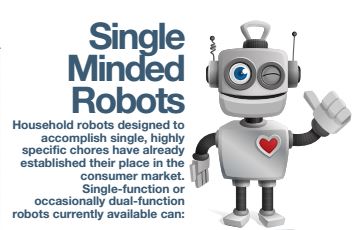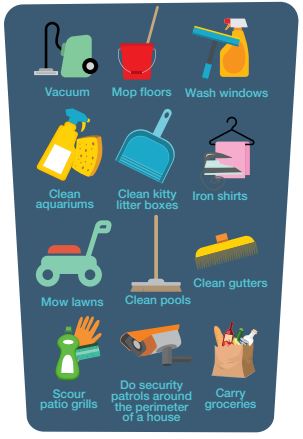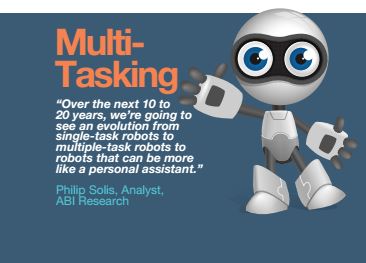by | Rushdi Abdul Rahim
In order to master a variety of domestic tasks in human homes, robots will need to improve their ability to manipulate objects of different sizes, shapes and textures.
Will There be A Robot in Every Home?
The Introduction introduction of the Roomba in 2002 seemed to herald the arrival of a new era in which robots would take over household chores and become ubiquitous: ‘a robot in every home’.
While the Roomba achieved notable success—selling more than 10 million units worldwide— and robotics technology has advanced considerably since the beginning of the century, the eagerly anticipated advent of multitask domestic robots has yet to arrive. Technological obstacles and cost barriers continue to hinder the introduction and wide-scale adoption of domestic robots.
Robots have certainly expanded their presence and their utility in industrial settings over the last dozen years. Yet household ‘robots’ have for the most part been limited to relatively simple, single-function machines designed to accomplish specific circumscribed tasks: one that vacuums; one that washes windows; one that cleans kitty litter; one that mows lawns; and so on. Although researchers, scientists, and inventors are making progress in the development of affordable, versatile, multi-task robots for home use, these robots have not yet arrived in the marketplace.
“In order to master a variety of domestic tasks in human homes, robots will need to improve their ability to manipulate objects of different sizes, shapes and textures.”
This article identifies and outlines the challenges that still face the creators of domestic robots; describes research and advances in robotics technology that demonstrates progress in meeting those challenges; and examines the business implications of these advances and the coming age of domestic robots.
THE DRIVERS
An array of social, demographic, and economic forces are driving the research and development of better, more versatile robots for home use. They include:
Time Pressure
With consumers feeling that time is scarce, robots would provide a highly valued service by taking over mundane household chores — doing laundry, washing dishes or loading dishes in the dishwasher, scrubbing tubs and toilets, cleaning floors and windows, straightening up, unloading groceries, shoveling snow and the like. Consumer research has shown, for example, that people spend more time doing laundry than any other household task.


Quality of Life
An ICM poll in 2011 found that 82% of consumers said they would use any product that increased their free time at home. Freeing up time spent doing necessary but repetitive – and for most people boring household chores by relegating them to robots would allow consumers to devote more time to more enjoyable activities – or to more career-related work.
Aging
The UN estimates that the number of people over age 65 will jump 181% worldwide between 2010 and 2050. The growing number of consumers who want to age in place – to remain in their homes rather than move to long-term care facilities – will heighten demand, not only for healthcare and personal-care robots, but also for robots that can handle chores that aging consumers find increasingly difficult to manage on their own.
Consumer Demand
The market for robots that perform household chores is already established and growing rapidly. Consumer robotics is currently a $1.6 billion industry — and taskoriented robots account for about half of that total. ABI Research projects that consumer robotics sales could reach $6.5 billion by 2017. Recent surveys have consistently found that a majority of consumers (55–61%) would like to buy a robot to do household chores.
Despite these drivers, multi-task robots have not yet reached the marketplace. However, ongoing research and development efforts are aimed at achieving this goal.
TECHNICAL CHALLENGES
Robots are becoming increasingly autonomous, intelligent, and responsive. Yet, before multi-task domestic robots can begin making their way into consumers’ homes, a number of technical challenges must first be met.
Sensing
Domestic robots require real-world dynamic sensing and equipped with the intelligence to interpret sensor data. The more robots can sense, perceive, interpret, and interact with their immediate surroundings, the more functional they will be.
“To function effectively in the home where they will confront many variables and unforeseen occurrences, robots need to move freely, intelligently, and safely through their surroundings; an environment shared with human owners”

Research and development aimed at improving the sensory capacity of robots is ongoing. In 2011, IBM forecasted significant enhancement of computers’ sensing abilities — particularly vision, hearing, and smell — by the end of this decade. The growing availability of 3D sensors is already helping robots to improve perceptive abilities and more accurately place themselves within their surroundings. And one of the announced objectives of James Dyson’s new London robotics center involves enhancing robot vision, allowing robots to better see and respond to objects around them.
Jibo, billed as the ‘world’s first family robot’ and due to be launched by MIT Media Lab by the 3rd quarter of 2015, has a limited array of functionality – reading aloud, taking photos, delivering emails and reminders. Jibo does, however, use its cameras and other sensing devices to distinguish different objects and individuals. For example, it can identify faces and then behave differently to each member of a household.
Honda’s Asimo robot, now in its sixth iteration but not yet available for purchase, has steadily expanded its sensory abilities. It is able to recognize voices, sounds, and images since its first version in 2000. Asimo in subsequent versions has enhanced this ability — adding movement and gesture recognition, and sensors that provide visual and ultrasonic, as well as ground recognition inputs that enable it to maintain balance and stability by keeping a robotic foot perpendicular to any ground surface.
As an intermediate step to identifying a wide selection of objects, Georgia Tech researchers have developed a system using RFID tags that allows robots to search out and find specific hidden or ‘lost’ objects. The system involves labeling objects such as hairbrush, mobile phone, TV remote, medicine bottle, etc. with distinct ultra-high-frequency RFID tags. A robot equipped with two articulated antennas can then zero in on the signal sent by a tag and move toward it, thereby locating an object the user wants to find.
Manipulation
In order to master a variety of domestic tasks in human homes — environments that tend to be messier and less structured than factory floors — robots will need to improve their ability to manipulate objects of different sizes, shapes, and textures. With industrial robots, success in robotic manipulation has been achieved through high-precision motors, rigid links, and grippers. Yet these components would be unsafe, too heavy, and prohibitively expensive for home use.
Paolo Pirjanian, chief technology officer for iRobot, calls low cost manipulation the ‘missing link in robotics’. As this comment suggests, iRobot is focusing R&D resources on developing robotic manipulation appropriate for home use, and at a cost viable for the home market. Whenever possible, for example, iRobot seeks to substitute plastic parts for steel.
Working with researchers at Harvard and Yale, iRobot has developed a dexterous three-fingered hand capable of holding a basketball or picking up keys from a tabletop. Researchers found that incorporation of rubber in the hand’s joints introduced a springiness that improves the grip while eliminating the necessity of specifying the position of each finger in order to pick up different objects. They also found that three fingers seem sufficient to grasp and manipulate most objects. Both methods also accomplished the aim of lowering costs — and iRobot intends to apply the design advances made in its robotic hands to likewise improve the flexibility of robotic arms.

Research and development aimed at improving the sensory capacity of robots is ongoing. In 2011, IBM forecasted significant enhancement of computers’ sensing abilities — particularly vision, hearing, and smell — by the end of this decade. The growing availability of 3D sensors is already helping robots to improve perceptive abilities and more accurately place themselves within their surroundings. And one of the announced objectives of James Dyson’s new London robotics center involves enhancing robot vision, allowing robots to better see and respond to objects around them.
Jibo, billed as the ‘world’s first family robot’ and due to be launched by MIT Media Lab by the 3rd quarter of 2015, has a limited array of functionality – reading aloud, taking photos, delivering emails and reminders. Jibo does, however, use its cameras and other sensing devices to distinguish different objects and individuals. For example, it can identify faces and then behave differently to each member of a household.
Honda’s Asimo robot, now in its sixth iteration but not yet available for purchase, has steadily expanded its sensory abilities. It is able to recognize voices, sounds, and images since its first version in 2000. Asimo in subsequent versions has enhanced this ability — adding movement and gesture recognition, and sensors that provide visual and ultrasonic, as well as ground recognition inputs that enable it to maintain balance and stability by keeping a robotic foot perpendicular to any ground surface.
As an intermediate step to identifying a wide selection of objects, Georgia Tech researchers have developed a system using RFID tags that allows robots to search out and find specific hidden or ‘lost’ objects. The system involves labeling objects such as hairbrush, mobile phone, TV remote, medicine bottle, etc. with distinct ultra-high-frequency RFID tags. A robot equipped with two articulated antennas can then zero in on the signal sent by a tag and move toward it, thereby locating an object the user wants to find.
Manipulation
In order to master a variety of domestic tasks in human homes — environments that tend to be messier and less structured than factory floors — robots will need to improve their ability to manipulate objects of different sizes, shapes, and textures. With industrial robots, success in robotic manipulation has been achieved through high-precision motors, rigid links, and grippers. Yet these components would be unsafe, too heavy, and prohibitively expensive for home use.
Paolo Pirjanian, chief technology officer for iRobot, calls low cost manipulation the ‘missing link in robotics’. As this comment suggests, iRobot is focusing R&D resources on developing robotic manipulation appropriate for home use, and at a cost viable for the home market. Whenever possible, for example, iRobot seeks to substitute plastic parts for steel.
Working with researchers at Harvard and Yale, iRobot has developed a dexterous three-fingered hand capable of holding a basketball or picking up keys from a tabletop. Researchers found that incorporation of rubber in the hand’s joints introduced a springiness that improves the grip while eliminating the necessity of specifying the position of each finger in order to pick up different objects. They also found that three fingers seem sufficient to grasp and manipulate most objects. Both methods also accomplished the aim of lowering costs — and iRobot intends to apply the design advances made in its robotic hands to likewise improve the flexibility of robotic arms.
Artificial Intelligence
Advances in the development of artificial intelligence will significantly contribute to the ability of robots to function in a home. In addition to needing the intelligence to recognize the objects they see, robots will need a ‘structured deep learning’ that will allow them to translate sensor data into appropriate action.
It’s impossible to program a robot in advance to handle every situation that might possibly arise in an unprogrammed limitless home setting. For this reason, robots will need to be able to process new data, learn new skills, and make decisions about what actions to take in new situations. They need to be equipped with artificial intelligence tools that allow them to make appropriate decisions when the need arises.
Cloud computing will likely help expand the capabilities of domestic robots. Mapping a robot’s immediate environment and developing its understanding of the thousands of objects in that environment requires vast amounts of storage. But storing the knowledge that a robot needs to function efficiently in the cloud will avoid burdening the robot with the need for extra storage.
Robo Brain – a project at Cornell and four other universities, sponsored by Google, Microsoft, the US Army and Navy, and the National Science Foundation, among others — aims to create a collaborative cloud-based system through which all future robots can access information. Aspiring to amass the sum total of all human knowledge, Robo Brain has already absorbed more than 120,000 YouTube videos, 100 million documents, and one billion images.
Access to a cloud-based knowledge bank will also make home robots more adaptable, allowing them to learn new things and master new tasks. Rather than robots having to be taught or programmed to do new tasks, Robo Brain will enable robots to ‘learn’ how the world works and make sense of new information. Its creators anticipate that Robo Brain will be usable on a large scale by 2017.
The University of Washington is also developing a system to facilitate robot learning. The Washington system would enable robots to crowdsource difficulties and new situations, allowing them to seek assistance in attempts to learn and master new tasks. Robots are programmed to consult an online community for input on the best way to accomplish a new task. The robot then analyzes and chooses the best alternatives offered by the community.
“Although mapping a robot’s immediate environment and developing its understanding of the thousands of objects in that environment requires vast amounts of storage, storing the knowledge that a robot needs to function efficiently in the cloud will avoid burdening it with the need for extra storage.”
Cost
Although prototypes have demonstrated that useful humanoid robots can be built, they remain affordable only to government agencies and the large business and corporations.
• Atlas, Boston Dynamics’ agile, mobile, walking robot, costs more than US$ 1 million.
• Honda’s Asimo is not for sale, and monthly rental costs are reputed to be in the six-figure range.
• UBR-1, a one-armed robot from Unbounded Robotics, costs US$35,000.
• Baxter, a robot from Rethink Robotics that handles simple, repetitive chores, costs US$22,000.
With the cost of robots so high, research is currently focusing on driving down the price of components used to create robot legs, arms, hands, and even machine intelligence. Using less expensive technology would put the price of domestic robots in the reach of some consumers. By making robots more affordable would thus greatly expand the consumer market for them. A major factor in the high cost of robots is the expenses involved in manipulation. Developing less expensive robot hands and limbs that still deliver manipulation skills would therefore help bring costs into consumer’s range.
Lower-cost solutions to manipulation are being developed. Rich Mahoney, SRI International’s director of robotics, believes that current pricecutting advances in manipulation suggest that solutions could be developed for less than US$1,000 – bringing the overall cost of robots into the range of consumers. DARPA’s ARM-H program, for example, employs a cheaper, lighter and more efficient clutch mechanism to deliver lower-cost robotic hands. Reducing the number of fingers in a robot hand has also cut costs considerably. If manufactured in at least a few thousand, a threefingered hand developed by iRobot cost an estimated US$3,000 — less than 10% of the US$35,000 price tag of other robotic hands with similar capabilities.
Weight and Energy Efficiency
Two final problems that need to be tackled before multi-functional robots become appropriate for home markets are weight and energy efficiency.
While robots that have already been launched in the consumer market are relatively lightweight, virtually all of these robots are limited to performing just one or two tasks. Adding functions in order to develop multi-task robots adds to the weight and cost of the robots, making them both too heavy and too expensive to be commercially viable in a consumer market.
Energy inefficiency, which necessitates the use of massive batteries, adds significantly to the weight of robots. The Atlas, for example, requires 15 kilowatts of electricity — a massive amount of energy that severely limits its practicality due to the weight of the battery and affordability due to the high cost of such a large battery for home use. To make robots practical for home use, power consumption will therefore need to be dramatically reduced. A research team at the nonprofit SRI International is working with DARPA to redesign the Atlas robot to increase its energy efficiency. The team is replacing the hydraulics that move the robot’s joints with lighter, more efficient, and cheaper electric components. This, they believe, can maintain its capabilities while reducing the robot’s power usage by at least 20 times.
BUSINESS IMPLICATIONS
• Companies working in adjacent spaces should monitor robotics progress even if they have no plans to enter the field or make direct use of robots. These technological developments will involve advances in such areas as sensors, machine learning, and information technology which will have potential to be applied in adjacent areas of technology.
• When the robot industry masters the technological challenges and establishes a market for home robots, it will also create secondary market – maintenance, service, monitoring, and repair of robots. A market may also open up for services to ‘robot-proof’ homes, making them safe environments in which robots can operate without damaging themselves or other property.
• If the pricing of robots comes down very gradually, making them affordable only to the wealthiest consumers, a leasing or rental model may provide a useful interim step that paves the way for eventual sales as prices continue to come down. Renting a robot maid, for example, could be cheaper than or at least cost-competitive with hiring a human housecleaning crew. Offering robots to rent or lease could whet the consumer appetite to own robots as they become more affordable.
• The expansion of robotic applications into the home depends heavily on the development of new capabilities in human-robot interaction. Researchers and businesses with new technologies to offer in this arena will find companies eager to incorporate them.
• As Google’s recent acquisition of robotics companies suggests, the proliferation of robots into the home will likely lead to a new source of data on how consumers live. Like Google cars, Google robots will increase demand for data that Google and others can supply and provide data and insights about how consumer lives. The intimate data that robots can provide will open up privacy concerns and implications of big data. With domestic robots taking their place in a growing number of homes, consumers may respond negatively to perceived and actual intrusions into their privacy.
• The development of domestic robots that can handle home chores will facilitate the desires of a rising number of senior consumers who want to age in place. Enabling more aging consumers to live in place will create new needs for other sensor networks for monitoring and safety or personal-care robots to bathe or groom consumers, and also heighten demand for single-serving meals and other products intended for older consumers who live alone.
• As sensory capabilities improve, future security robots will transform the security industry. In addition to patrolling the perimeter of a residence, security robots may be able to use chemical sensors to detect a fire or gas leak, as well as hearing and vision to detect a break-in.
• Consumers will likely set the bar for robot safety very high, demanding safeguards to ensure that the machines they allow into their homes do not harm occupants, invited guests, or pets. Consumers will not tolerate ‘clumsy’ robot operations that cause damage to property either.
• Nonetheless, robot error — whether caused by mechanical or technological failure or by operator error — could lead to substantial liability issues. Robot malfunctions and operator error will therefore create new areas for home insurance and liability coverage — insuring against damage done to persons and property by robots as well as damage done to robots
“Adding functions in order to develop multi-task robots increases their weight and cost, making them both too heavy and too expensive to be commercially viable in a consumer market.”
References
1. Roxie Hammill and Mike Hendricks, “More Dreaded Chores Outsourced to Robots (They Do Windows),” New York Times, March 2014
2. Tom Simonite, “Three Questions for iRobot’s CTO Paolo Pirjanian,” MIT Technology Review, April 2014
3. Bobbie Johnson, “Will Household Robots Ever Change Our Lives?” The Guardian, December 2014
4. “Twelve Robots That Have Invaded American Homes,” Boston.com, December 2014
5. Chuck Tesla, “The Robot Revolution—The Rise of Domestic Robots,” Tumotech, May 2014
6. Will Knight, “Your Retirement May Include a Robot Helper,” MIT Technology Review, October, 2014
7. “Consortium Sets Sights on Robots That Do Household Chores,” Nikkei Asian Review, July 2014
8. Adam Withnall, “A Robot in Every Home: Dyson Enters Race to Provide ‘Advanced Household Androids’ for All,” Independent, February 2014,
9. Will Knight, “Google’s Latest Robot Acquisition Is the Smartest Yet,” MIT Technology Review, December 2013
10. Will Knight, “Why Is Google Buying So Many Robot Startups?” MIT Technology Review, December 2013,
11. Colin Jeffrey, “JIBO Family Robot Wants to Join the Household,” Gizmag, July 2014
12. Clark Estes, “The World’s First Family Robot Could Be Like HAL in Your Home,” Gizmodo, July 2014
13. Stu Robarts, “Honda’s New ASIMO Robot Is All Grown Up,” Gizmag, July 2014
14. Brian Coxworth, “RFID Tags May Help Household Robots Locate Hidden Objects,” Gizmag, September 2014
15. Andrew Liszewski, “This Laundry Bot Will Only Eradicate Stains, Not Humans,” Gizmodo, December 2014
16. Tom Simonite, “Cheaper Joints and Digits Bring the Robot Revolution Closer,” MIT Technology Review, April 2014
17. Stu Robarts, “SaviOne Robot Butler Starts Room Service Deliveries This Week,” Gizmag, August 2014
18. Stu Robarts, “Cat-like Whiskers Could Help Robots Navigate,” Gizmag, January 2014
19. Paul Gilster, “Why Robot Home Helpers Are Likely Years Away,” News & Observer, August 2014
20. Stu Robarts, “Robo Brain Uses the Web to Teach Robots Human Knowledge,” Gizmag, August 2014
21. David Szondy, “Crowdsourcing Could Help Robots Learn New Tasks Faster,” Gizmag, June 2014
22. Stu Robarts, “Robo Brain Uses the Web to Teach Robots Human Knowledge,” Gizmag, August 2014
23. Stephen Clemenger, “Bio-likeness: Getting the Feel of Our Robotic Future,” Gizmag, July 2014
24. “A Robot In Every Home”, Future in Focus, December 2014










